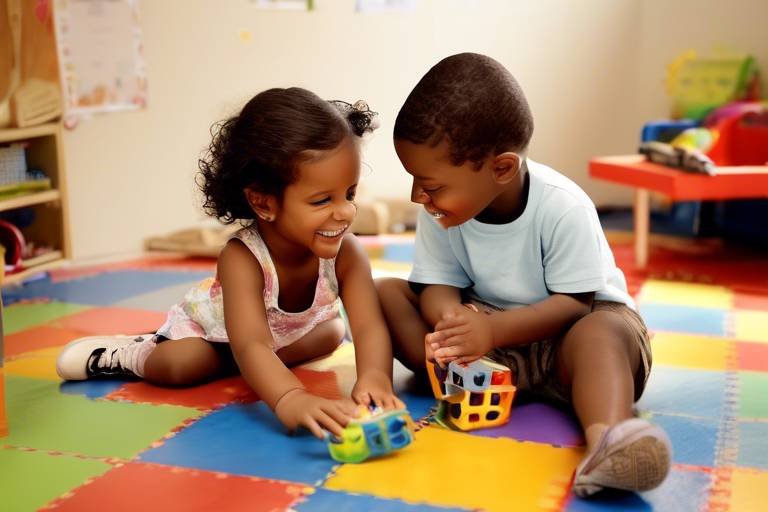Managing Your Child’s Expectations: A Guide
As parents, we often find ourselves navigating the complex world of our children's emotions and aspirations. Managing your child's expectations effectively is not just about saying "no" or "yes"—it's about guiding them to understand the importance of realistic goals and nurturing their resilience in the face of inevitable disappointments. Imagine a young tree bending in the wind; it may sway, but with the right support, it can grow strong and upright. In a similar way, when we help our children set and manage their expectations, we are essentially providing them with the necessary support to thrive in life's unpredictable environment.
Understanding the stages of child development is crucial for parents to set appropriate expectations. Each stage brings unique capabilities and limitations that influence how children perceive their surroundings and experiences. For instance, toddlers are still learning to express their emotions, while teenagers are beginning to grapple with complex social dynamics. Recognizing these differences can help us tailor our expectations to better suit our child's developmental stage. By doing so, we allow them to grow and learn at a pace that is comfortable yet challenging, fostering a sense of achievement without overwhelming them.
Effective communication is key to managing expectations. Parents should engage in open dialogues with their children, encouraging them to express their thoughts and feelings while guiding them toward realistic outcomes. Think of communication as a bridge; it connects your child's dreams with the reality of their capabilities. By asking open-ended questions and actively listening, you can help your child articulate their desires and understand the steps needed to achieve them. This not only builds trust but also empowers children to take ownership of their goals.
Helping children set achievable goals fosters a sense of accomplishment. Parents can guide their children in setting SMART (Specific, Measurable, Achievable, Relevant, Time-bound) goals that align with their abilities and aspirations. For example, instead of stating, "I want to get an A in math," encourage them to say, "I will study for 30 minutes every day this week to prepare for my math test." This shift in language not only clarifies the goal but also makes it more attainable. By celebrating small victories along the way, you can further motivate your child to strive for success.
Teaching resilience is vital in helping children cope with disappointment. Life is filled with ups and downs, and it's essential for children to learn how to navigate these challenges. Parents can model resilience by sharing their own experiences of overcoming obstacles. Moreover, providing coping strategies—such as practicing mindfulness or engaging in physical activity—can empower children to bounce back from setbacks. When they learn that failure is not the end but a stepping stone to success, they develop a robust mindset that will serve them well throughout their lives.
Children often mirror their parents' attitudes. By modeling healthy expectations and demonstrating how to handle disappointment, parents can instill a balanced perspective in their children regarding success and failure. For instance, if a child sees their parent reacting calmly to a setback, they are likely to adopt a similar approach. Use real-life examples to show that it's okay to be disappointed and that what matters is how we respond to those feelings. This teaches children that while it’s natural to have high hopes, it’s also important to remain grounded.
Every child is unique, with different strengths and weaknesses. Acknowledging these individual differences allows parents to tailor their expectations and support, ensuring that each child feels valued and understood. For example, one child may excel in sports while another shines in academics. By recognizing and celebrating these differences, parents can help their children set personal goals that resonate with their individual talents and interests, rather than comparing them to others.
A nurturing environment encourages children to express their feelings and expectations freely. Parents can foster this by being present, listening actively, and validating their child's experiences and emotions. Create a safe space where your child feels comfortable sharing their thoughts without fear of judgment. This supportive atmosphere will not only strengthen your bond but also encourage open communication, making it easier for them to voice their expectations and concerns.
Focusing on effort rather than just results helps children appreciate the journey. Parents should celebrate their child's hard work, reinforcing the idea that effort is just as important as achieving specific goals. For instance, if your child puts in a lot of effort for a project but doesn't achieve the desired grade, take the time to acknowledge their dedication and hard work. This approach fosters a growth mindset, teaching children that persistence and determination are key components of success.
- How can I help my child cope with disappointment? Teach them coping strategies, model resilience, and encourage open discussions about their feelings.
- What are SMART goals? SMART goals are Specific, Measurable, Achievable, Relevant, and Time-bound objectives that help children set realistic expectations.
- Why is communication important in managing expectations? Open communication allows children to express their thoughts and feelings, helping them understand the reality of their goals.

Understanding Child Development
Understanding child development is like embarking on a fascinating journey through the stages of growth and learning. Each stage brings its own set of capabilities and limitations, which can significantly influence how children perceive their surroundings and experiences. For parents, this understanding is crucial in setting appropriate expectations for their children. It’s not just about knowing when a child should start walking or talking; it’s about grasping the intricate web of emotional, social, and cognitive development that unfolds during these formative years.
From the moment a child is born, they begin to interact with the world in unique ways. In the early years, infants are primarily focused on sensory experiences. They explore through touch, taste, and sight, which is why they often put everything in their mouths. As they grow into toddlers, their curiosity expands, and they start to test boundaries, leading to a phase filled with both wonder and frustration. This is the time when parents might find themselves asking, “Why?” a hundred times a day, as their little ones seek to understand their environment.
As children transition into preschool and elementary school ages, their cognitive abilities develop further. They begin to understand concepts such as sharing and empathy, which are essential for social interactions. It’s during these stages that parents can help their children set realistic expectations for their behavior and academic performance. For instance, while it’s natural to want your child to excel in school, understanding that each child has their own pace of learning can help mitigate disappointment.
To illustrate the stages of child development, let’s look at a simple table that outlines the key characteristics of each stage:
| Age Range | Developmental Focus | Key Characteristics |
|---|---|---|
| 0-2 years | Sensory and Motor Skills | Exploration through senses, developing motor skills |
| 2-4 years | Language and Social Skills | Rapid language acquisition, testing boundaries |
| 4-7 years | Cognitive and Emotional Development | Understanding of rules, empathy, and basic problem-solving |
| 7-12 years | Academic and Social Skills | Improved focus, teamwork, and self-regulation |
By paying attention to these developmental milestones, parents can better align their expectations with their child’s capabilities. It’s essential to remember that every child is unique. Just because one child can read at a certain age doesn’t mean another should be expected to do the same. This understanding fosters a nurturing environment where children feel supported and valued for who they are, rather than who they are expected to be.
Moreover, engaging in open conversations about these developmental stages can empower parents to guide their children effectively. By asking questions like, “What do you think you can achieve this year?” or “How do you feel about your progress in school?” parents can help their children articulate their thoughts and feelings, reinforcing a healthy approach to expectations.
In summary, understanding child development is not just about recognizing the stages but also about appreciating the individual journey of each child. By setting realistic expectations based on these developmental insights, parents can help their children navigate the complexities of growing up with confidence and resilience.

The Role of Communication
Effective communication is the backbone of managing your child's expectations. It’s not just about talking; it’s about creating a two-way street where both parents and children feel heard and understood. Imagine trying to navigate a maze without a map; that’s how children can feel when expectations are unclear or unrealistic. By fostering open dialogues, you allow your child to express their thoughts and feelings, which is crucial for their emotional development.
When parents engage in meaningful conversations, they can help their children articulate their desires and fears. For instance, if a child is anxious about an upcoming test, a parent can encourage them to share their worries. This not only alleviates anxiety but also provides an opportunity to discuss realistic outcomes and the importance of preparation. It’s like teaching them to ride a bike: they need to learn how to balance before they can zoom down the street!
Furthermore, using active listening techniques can enhance communication. This means not just hearing the words your child says, but also paying attention to their body language and emotional cues. When children feel that their parents are genuinely interested in what they have to say, it builds trust and encourages them to open up more. You can show that you’re listening by nodding, maintaining eye contact, and repeating back what they’ve said to confirm understanding.
To effectively manage expectations, parents should also clarify their own expectations. It’s essential to communicate what you hope for your child in a way that is both encouraging and realistic. For example, instead of saying, “You must get an A on your next test,” try framing it as, “I believe you can do well if you study and ask for help when you need it.” This subtle shift in language not only sets a standard but also empowers your child to take ownership of their learning journey.
Moreover, consider incorporating regular family meetings into your routine. This can be a fantastic platform for discussing expectations, goals, and feelings. During these meetings, everyone can share their thoughts in a safe environment, fostering a sense of community and support. It’s a chance for children to practice articulating their feelings and for parents to model how to communicate effectively. Think of it as a family huddle where everyone gets to play a part in the game!
In conclusion, the role of communication in managing your child's expectations cannot be overstated. By creating an open, trusting environment where feelings are validated and discussed, parents can help their children navigate the complexities of their emotions and aspirations. Remember, it’s not just about what you say, but how you say it and how well you listen. This foundation will not only aid in setting realistic expectations but will also strengthen the parent-child bond, providing a safe space for growth and understanding.
- How can I encourage my child to express their feelings? - Start by modeling emotional expression yourself. Share your feelings openly and encourage your child to share theirs during conversations.
- What if my child has unrealistic expectations? - Gently guide them towards more realistic goals by discussing their capabilities and helping them understand the difference between aspirations and achievable outcomes.
- How often should we have family meetings? - Aim for at least once a week, but feel free to adjust based on your family's needs. The key is consistency!

Setting Realistic Goals
Setting realistic goals for children is like giving them a roadmap to success. Just imagine embarking on a road trip without a map or GPS; you’d probably end up lost or frustrated. Similarly, children need guidance to navigate their aspirations effectively. By helping them set achievable goals, you’re not just fostering a sense of accomplishment but also teaching them the invaluable skill of planning for the future. So, how do you go about this? It starts with understanding the concept of SMART goals—Specific, Measurable, Achievable, Relevant, and Time-bound.
Let’s break this down a bit. When you set a Specific goal, it should be clear and well-defined. Instead of saying, "I want to be better at math," encourage your child to say, "I want to improve my math grade from a C to a B." This clarity helps them understand exactly what they are aiming for. Next, the goal should be Measurable. This means there should be a way to track progress. You might set up regular check-ins to see how they are doing on their assignments, which can help them stay motivated.
The third element, Achievable, is crucial. It’s important to ensure that the goals set are within reach. You wouldn’t want your child to aim for something as unrealistic as becoming a world-renowned scientist overnight! Instead, help them set smaller milestones, like completing a science project or participating in a science fair. This not only makes the goal more attainable but also builds their confidence as they achieve each step.
Next up is Relevant. The goals should resonate with your child’s interests and skills. If your child loves art, a goal could be to create a portfolio of their artwork rather than forcing them into sports if they have no interest in it. When children see the relevance of their goals, they are more likely to stay committed to achieving them.
Finally, we have Time-bound. Setting a deadline creates a sense of urgency and motivation. You might say, "Let’s aim to achieve this by the end of the semester." This not only helps them stay focused but also teaches them about managing their time effectively, a skill that will benefit them throughout their lives.
To summarize, here are the key components of setting realistic goals:
| Component | Description |
|---|---|
| Specific | Clearly define the goal. |
| Measurable | Establish criteria for tracking progress. |
| Achievable | Ensure the goal is attainable. |
| Relevant | Align the goal with interests and skills. |
| Time-bound | Set a deadline for achieving the goal. |
Remember, the journey of goal-setting should be a collaborative effort. Engage your child in the process, allowing them to voice their aspirations and concerns. This not only empowers them but also strengthens your relationship as they see you as a supportive partner in their growth. Ultimately, by setting realistic goals, you are equipping your child with the tools they need to navigate life's challenges with confidence and resilience.

Encouraging Resilience
When it comes to parenting, one of the most valuable gifts you can give your child is the ability to bounce back from setbacks. Resilience is like a muscle; the more you work it, the stronger it becomes. So, how can you help your child develop this essential skill? It's all about teaching them that failure is not the end of the world but rather a stepping stone to success. Imagine resilience as a rubber band—it stretches but doesn’t break, allowing your child to return to their original shape after facing challenges.
One effective way to encourage resilience is by modeling it yourself. Children are keen observers, often mimicking the behaviors and attitudes of their parents. When you face difficulties, let your child see how you cope. Talk about the challenges you encounter and how you overcome them. By sharing your experiences, you not only provide a real-life example but also show them that it's okay to struggle and that persistence is key. Remember, your reactions to life's ups and downs can significantly influence how they perceive and handle their own challenges.
Additionally, providing your child with coping strategies can empower them to deal with disappointments more effectively. Here are a few techniques you might consider:
- Problem-solving skills: Encourage your child to brainstorm solutions when they face a challenge. This not only helps them feel more in control but also fosters critical thinking.
- Positive self-talk: Teach them to replace negative thoughts with positive affirmations. Instead of saying, "I can't do this," encourage them to say, "I will try my best." This shift in mindset can work wonders.
- Emotional regulation: Help your child recognize and express their feelings. Sometimes, just talking about what they’re feeling can relieve stress and prevent overwhelming emotions.
Creating a safe space for your child to express their feelings is crucial. When they know they can share their disappointments without judgment, they are more likely to develop a healthy approach to facing challenges. Ask open-ended questions like, "How did that make you feel?" or "What do you think you could do differently next time?" This not only validates their emotions but also encourages them to think critically about their experiences.
Finally, remember to celebrate your child's efforts, not just their successes. When they put in hard work, regardless of the outcome, acknowledge it. This reinforces the idea that trying and learning are just as important as winning or achieving a goal. For example, if your child practices for a sports event but doesn’t win, you might say, "I’m so proud of you for practicing hard and giving it your all! That's what really matters." This approach instills a sense of pride and encourages them to keep trying, fostering resilience in the face of future challenges.
Q: How can I tell if my child is struggling with resilience?
A: Signs may include excessive frustration, avoidance of challenges, or a tendency to give up easily. Open communication can help you gauge their feelings and struggles.
Q: Is resilience something that can be taught?
A: Absolutely! Resilience can be nurtured through modeling behaviors, teaching coping strategies, and providing a supportive environment.
Q: What age should I start teaching resilience?
A: It's never too early! Even young children can learn basic coping strategies and the importance of perseverance.

Modeling Healthy Expectations
As parents, we often find ourselves in the role of both teacher and role model. One of the most profound lessons we can impart to our children is the concept of healthy expectations. Children are like sponges, absorbing everything around them, including our attitudes towards success and failure. When we demonstrate how to handle disappointment gracefully, we equip them with the tools they need to navigate life's ups and downs.
Imagine a scenario where your child comes home with a less-than-stellar report card. Instead of expressing frustration, you can take a moment to reflect on the effort they put into their studies. By acknowledging their hard work and discussing areas for improvement without harsh judgment, you are modeling a balanced perspective. This approach teaches children that it’s not just about the end result, but also about the journey they take to get there.
To effectively model healthy expectations, parents can adopt the following strategies:
- Share your experiences: Talk about your own challenges and how you dealt with them. This not only normalizes setbacks but also shows that they are a part of life.
- Encourage a growth mindset: Emphasize that abilities can be developed through dedication and hard work. This perspective fosters resilience and a love for learning.
- Be transparent about your feelings: It's okay to express disappointment, but it's crucial to demonstrate how to cope with those feelings positively. This teaches children that emotions are valid but can be managed constructively.
In addition, it's essential to create an atmosphere where children feel safe to express their own feelings and expectations. When they see you handling your own challenges with a positive outlook, they are more likely to adopt a similar mindset. This modeling can be particularly effective during times of stress, such as during exams or sports competitions, where the pressure to succeed can be overwhelming.
Ultimately, the goal is to help children understand that while it's great to aim high, it's equally important to accept that failure is a part of growth. By modeling healthy expectations, you’re not just preparing them for success; you're teaching them how to rise after a fall, instilling a sense of resilience that will serve them well throughout their lives.
Q: How can I help my child cope with disappointment?
A: Encourage open conversations about their feelings. Validate their emotions and share your own experiences with disappointment to show that it’s a natural part of life.
Q: What are some signs that my child has unrealistic expectations?
A: Look for signs of anxiety, frustration, or withdrawal when they face challenges. If they set goals that seem too ambitious for their age or ability, it may indicate unrealistic expectations.
Q: How can I encourage a growth mindset in my child?
A: Praise their efforts rather than outcomes, encourage them to take on challenges, and remind them that mistakes are opportunities for learning.
Q: Is it okay to express my own disappointments in front of my child?
A: Yes, it’s important to be authentic. Just ensure you also demonstrate how to cope with those feelings positively, so your child learns from your example.

Recognizing Individual Differences
Every child is a unique masterpiece, painted with different colors of personality, strengths, and weaknesses. As parents, it’s essential to embrace this diversity and understand that each child has their own pace and style of learning. Just like how no two snowflakes are alike, children come with their individual quirks and capabilities. Recognizing these differences is not just important; it’s crucial for their development and self-esteem.
When we talk about individual differences, we refer to the variations in traits such as temperament, intelligence, interests, and learning styles. For instance, one child might excel in mathematics but struggle with reading, while another might be a budding artist who finds joy in creating rather than calculating. As a parent, it’s your job to identify and nurture these unique traits. By doing so, you help your child feel valued and understood, which is the bedrock of a healthy self-image.
To effectively recognize and support your child's individual differences, consider the following strategies:
- Observation: Spend time watching how your child interacts with the world. What activities light up their eyes? What challenges do they shy away from? This will give you insights into their strengths and areas needing support.
- Communication: Have open conversations with your child about their interests and feelings. Ask them what they enjoy and what frustrates them. This dialogue can reveal their unique perspective and needs.
- Encouragement: Celebrate your child's unique abilities. Whether they’re a whiz at science or a fantastic storyteller, acknowledging their strengths boosts their confidence and motivates them to pursue their passions.
Moreover, it's vital to avoid the trap of comparison. Comparing your child to siblings, peers, or even other children can be detrimental. Instead of fostering competition, it can create feelings of inadequacy and resentment. Remember, every child is on their own journey. They will bloom in their own time, and your role is to provide the right environment for that growth.
In addition, consider creating a personalized approach to learning. This could mean adapting homework assignments to suit their learning style or providing resources that resonate with their interests. For instance, if your child loves dinosaurs, incorporating that theme into their reading material can make learning more engaging and effective.
Lastly, understanding that individual differences also extend to emotional responses is crucial. Some children may bounce back from disappointment quickly, while others may need more time to process their feelings. Acknowledging these emotional differences allows you to provide the right kind of support, whether it’s a comforting hug or a gentle nudge to try again.
In conclusion, recognizing and embracing individual differences in your child is not just about acceptance; it's about empowerment. By tailoring your expectations and support to fit their unique needs, you help them navigate the world with confidence and resilience. Remember, every child's journey is special, and as a parent, you have the incredible opportunity to guide them along their path.
- How can I identify my child's unique strengths?
Spend time engaging in various activities with your child and observe what they enjoy and excel at. Keep an open line of communication to understand their interests better. - What should I do if my child struggles in certain areas?
Focus on their strengths while providing support in areas where they struggle. Consider seeking additional resources or tutoring that aligns with their learning style. - How can I avoid comparing my children to each other?
Emphasize each child's unique journey and celebrate their individual achievements. Acknowledge that each child has their own strengths and challenges.

Creating a Supportive Environment
Creating a supportive environment for your child is not just about having a cozy home; it's about fostering a space where they feel safe to express their thoughts, emotions, and expectations. Imagine your home as a garden where your child's ideas and feelings can grow. Just as plants need sunlight and water, children need love, understanding, and encouragement to thrive. When parents actively listen and validate their child's feelings, they create a nurturing atmosphere that promotes open communication and trust.
One of the most effective ways to cultivate this supportive environment is by being present. This means putting down your phone, turning off the TV, and truly engaging with your child. Ask them about their day, their dreams, and even their worries. When children see that their parents are genuinely interested in their lives, it helps them feel valued and understood. This validation is crucial; it tells them that their feelings are legitimate and worthy of discussion.
Active listening is another pivotal element. It involves not just hearing what your child says but also understanding the emotions behind their words. For instance, if your child expresses disappointment about not winning a game, instead of brushing it off, acknowledge their feelings by saying something like, "I can see you're really upset about that. It's okay to feel disappointed." This approach teaches them that it's normal to experience a range of emotions and that they can share those feelings without fear of judgment.
Furthermore, creating a supportive environment includes setting aside time for family activities. Whether it's game night, cooking together, or simply going for a walk, these moments help strengthen the bond between you and your child. They also provide opportunities for your child to express their expectations and feelings in a safe space. During these activities, you can subtly guide them in understanding that while not every outcome will be perfect, the effort and experiences shared are what truly matter.
Lastly, it’s important to recognize that every child is different. Tailoring your approach to their individual needs can make a significant difference. Some children may thrive on verbal encouragement, while others might need a more hands-on approach. By observing and understanding your child's unique personality, you can adjust your support to best suit their needs. This individualized attention not only helps them feel more secure but also instills a sense of belonging and acceptance.
In summary, creating a supportive environment is about more than just being there; it’s about fostering a culture of understanding, validation, and encouragement. When children feel supported, they are more likely to develop realistic expectations and resilience, preparing them for the challenges they will face as they grow.
- How can I tell if my child feels supported? Look for signs such as open communication, willingness to share feelings, and a general sense of happiness and security in their environment.
- What are some activities I can do to create a supportive environment? Engage in family game nights, cooking together, or simply having regular check-ins about their day.
- How do I handle my child's disappointment? Acknowledge their feelings, provide comfort, and encourage them to talk about their emotions. This will help them process their disappointment in a healthy way.

Celebrating Efforts Over Outcomes
In today's fast-paced world, the pressure to achieve can be overwhelming for children. As parents, it's essential to shift the focus from mere outcomes to the journey that leads to those outcomes. Celebrating efforts over results is not just a nice sentiment; it’s a powerful way to nurture a child's self-esteem and intrinsic motivation. When children feel valued for their hard work, they learn that the process of trying is just as important as the end result. This approach can transform their perspective on success and failure, leading to a more fulfilling and resilient mindset.
Imagine this: your child works tirelessly on a school project. They spend hours researching, crafting, and refining their ideas. When the project is finally presented, the grade they receive may not reflect the effort they poured into it. Instead of solely focusing on the grade, you can highlight the dedication and creativity they demonstrated throughout the process. You might say, "I’m so proud of how hard you worked on this project! You really put in the effort, and that’s what matters most." This kind of affirmation reinforces the idea that effort is valuable and worthy of recognition.
To truly celebrate effort, consider implementing some strategies at home:
- Verbal Acknowledgment: Regularly express appreciation for your child's hard work, regardless of the outcome. Simple phrases like "I noticed how much time you spent on this" can go a long way.
- Rewarding Persistence: Create a reward system that emphasizes persistence. For instance, you could have a "hard work" jar where they can add a marble or token for every effort they make, regardless of the results.
- Reflect on Experiences: After completing a task, discuss what they learned during the process. This reflection helps them see the value in their efforts.
Additionally, it's crucial to model this behavior yourself. When you encounter challenges, share your experiences with your children. Show them how you value the effort you put in, not just the success that follows. This creates a culture of resilience within your home, where both parents and children understand that setbacks are part of life, and the effort to overcome them is what truly counts.
In summary, by celebrating efforts over outcomes, you help your child build a strong foundation of resilience, self-worth, and a love for learning. They begin to understand that every attempt is a stepping stone toward growth, and that’s a lesson that will serve them well throughout their lives.
Q: Why is it important to focus on effort rather than outcomes?
A: Focusing on effort helps children develop resilience and a growth mindset. It teaches them that hard work and perseverance are valuable, regardless of the immediate results.
Q: How can I effectively communicate the importance of effort to my child?
A: Use specific examples of their hard work in conversations, acknowledge their dedication, and encourage them to reflect on what they learned from their experiences.
Q: What are some activities to celebrate effort at home?
A: You can create a "celebration of effort" night where you share stories of hard work, create a family effort board to track and celebrate everyone’s efforts, or have a special treat for achieving personal bests.
Q: How do I handle my child’s disappointment in not achieving a desired outcome?
A: Acknowledge their feelings, encourage them to express their disappointment, and then guide them to focus on what they can learn from the experience and how they can improve next time.
Frequently Asked Questions
- What are some effective strategies for managing my child's expectations?
Managing your child's expectations involves open communication, setting realistic goals, and modeling healthy attitudes. Engage in conversations about their feelings and thoughts, help them set SMART goals, and show them how to cope with disappointment by demonstrating resilience yourself.
- How can I help my child understand their developmental stage?
Understanding child development is key. Each stage has its own unique challenges and abilities. Share age-appropriate information with your child, and discuss how these stages affect their experiences. This helps them grasp what is realistic for their age and capabilities.
- What role does communication play in setting expectations?
Communication is vital! It creates a safe space for your child to express their thoughts and feelings. Encourage them to share their expectations and guide them gently toward more realistic outcomes. This two-way dialogue fosters trust and understanding.
- How can I encourage resilience in my child?
Encouraging resilience starts with modeling it yourself. Share stories of your own setbacks and how you overcame them. Teach your child coping strategies, like problem-solving and positive self-talk, so they can bounce back from disappointments and maintain a hopeful outlook.
- Why is it important to celebrate effort over outcomes?
Focusing on effort helps children appreciate the journey rather than just the destination. When you celebrate their hard work, it reinforces the idea that trying hard is just as valuable as achieving a specific goal. This builds a growth mindset and encourages persistence.
- How can I create a supportive environment for my child?
A supportive environment is all about being present and actively listening. Validate your child's feelings and experiences, and encourage them to express their expectations without fear of judgment. This nurturing atmosphere fosters open communication and emotional growth.
- What should I do if my child's expectations are unrealistic?
If you notice your child's expectations are unrealistic, gently guide them toward a more achievable perspective. Discuss the reasons why certain goals may be out of reach and help them adjust their expectations to align with their abilities and circumstances.
- How can I recognize and respect my child's individual differences?
Every child is unique! Take the time to observe their strengths and weaknesses. Tailor your expectations and support to fit their individual needs, ensuring they feel valued and understood. This personalized approach helps them thrive and boosts their self-esteem.



















